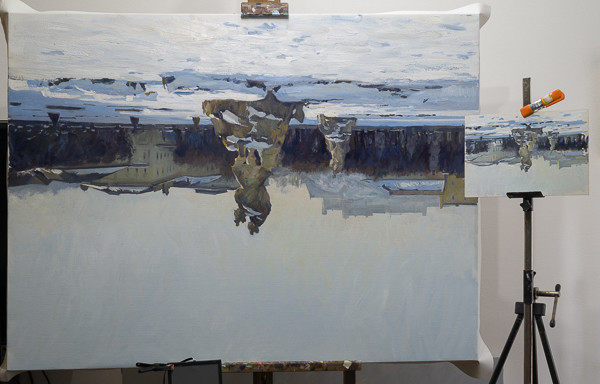
Currently on the easel.
Previously I wrote about using a mirror to correctly see shapes while working from life. This is a short post on the usefulness of painting with with your work upside down when inventing subject matter in the studio.
I’m currently in the process of enlarging some small plein air sketches from my Austrian trip into polished studio pieces. Much of the work requires, to some extent, inventing my subject. I find that flipping the painting upside down and observing the work free from the recognition of the objects helps me to quickly see some types of errors. Proportions and edges, especially, are two things that become easily noticable. In the gif below, the ‘before’ image shows how I originally painted the Hohensalzburg fortress above Salzburg as it appears in my sketch. Flipping the work upside down I immediately saw how the ‘steps’ were all exactly the same, so I shortened the bottom one, and raised the top one, to remove the repetitiveness.
Keeping variety in one’s edges is also important in painting. Surfaces that turn away from the viewer generally need a softer edge, elements where we want a focus are often given a sharper edge. Variety along the same edge can add interest to a work. As with repetition in shapes, turning the painting upside down makes it immediately obvious where the problems are with regards to the edges in the work.
It’s always been interesting to me how much of learning to paint is trying to rewire the way our brains see the world. In part this is because human beings evolved to see in an environment very different from the one we live in now. One of these adaptations is that our brain looks for patterns constantly, and my own observation is that seemingly unimportant areas in our vision, when painted, are forced into repetition that doesn’t exist in nature. For example, my students will paint every tree in a line of cypresses in Italy as being exactly the same: Tree, tree, tree, tree. The same goes for the shapes of a distant mountain. The line intervals are often drawn as being exactly the same, even if the direction of the line changes. In both cases, careful observation (or me pointing it out) shows that the cypresses are very different from each other, or that the segments of the line describing the outline of a mountain are very different, one from another.
From reading scientific theories about why this is, it appears that our brain filters out the ‘unimportant’ stuff by not focusing on the subtle differences in similar objects. This was in order to focus on things like predators, which would have been much more important for most of our evolution. This filtering out takes the form of generalizing individuality in aspects of the visual world. Part of learning to paint a landscape is learning to recognize this and focus on capturing exactly that variety in nature that our brain tries to ignore.
Another good example is the way students being taught cast drawing have to be told over and over to not look into the shadows. Once upon a time, looking into shadows was probably a very good idea for survival. In naturalistic painting, however, looking into shadows and painting the subtle differences usually results in an exaggeration of those differences when seen in relation to the whole image. It distracts the viewer’s eye (perhaps because their focus on what is in the shadow is compounded by the painter’s focus on what is in the shadow) and breaks up the sense of atmosphere of the work. ‘Less is more’ is the usual guideline when looking for detail in the shadow passages of a painting.
Turning one’s painting upside down forces the brain to see the subject as a series of abstract shapes. Without the immediate recognition of the objects, it becomes easier to see some of the basic pictorial rules being broken in our work.
Lastly, in the studio where I trained as a portraitist in Florence it was standard practice to keep the work in progress upside down on the walls so our eyes wouldn’t get used to them. The idea was that if we saw the paintings all day while we weren’t working on them, the images would some how be imprinted in our minds, and it would be harder to see the mistakes later while the work was next to the model. Today I still keep my work in progress upside down while not being worked on for this reason.
Thanks for the tips. The upside down treatment helped me immediately with 16×20″ painting I have spent two sessions on en plein air. Reversing it on the studio easel allowed me to readily see some design issues and i coule easily could gauge the vertical gradation in sky value and color.
A useful new technique. Thanks again.
Very interesting post. I will try this approach.
All the best.
Great post. I forget to do this but it is a good tool. I find I’ll spot problems in paintings when I look at a photograph of them. I wonder why that is?